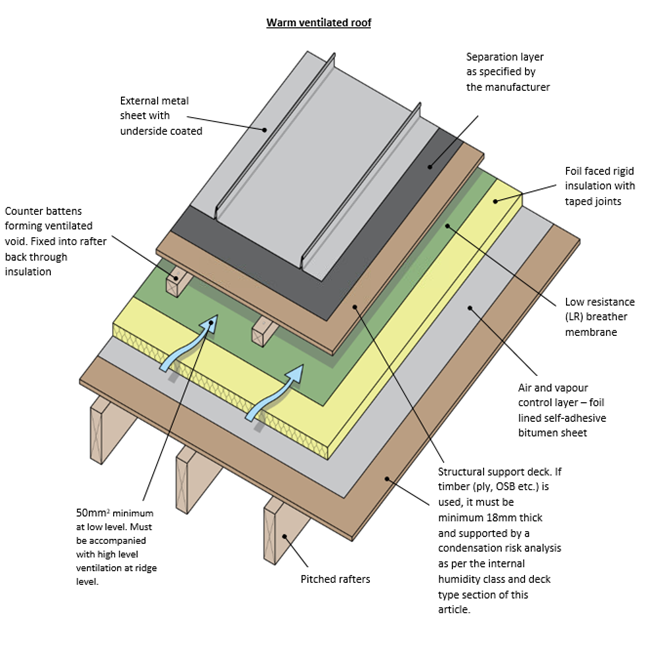Transform your property’s comfort and efficiency with warm roof construction – the modern solution that’s revolutionising UK homes and slashing energy bills.
Understanding Warm Roof Construction: The Basics
Warm roof construction represents a significant advancement in modern building technology, offering superior thermal performance and energy efficiency. This innovative roofing system, increasingly popular in UK construction, involves placing insulation above the roof deck, creating a continuous thermal barrier that maintains consistent temperatures throughout the roof structure. According to recent industry data, properties with warm roof systems have shown up to 25% reduction in heating costs compared to traditional roofing methods.
What is a Warm Roof System?
A warm roof system is an advanced roofing solution where the primary insulation layer sits above the structural deck, keeping the entire roof structure at a regulated temperature. This configuration ensures that the roof deck and supporting structure remain warm and protected from external temperature fluctuations. Recent studies indicate that 78% of new commercial buildings in the UK now opt for warm roof construction due to its superior performance.
Key Components of Warm Roof Construction
- Structural Deck: Usually timber or concrete, providing the base support
- Vapour Control Layer (VCL): Prevents moisture penetration
- Rigid Insulation Boards: High-performance thermal barrier
- Waterproof Membrane: Ensures weather protection
- Mechanical Fixings or Adhesives: Secures all layers together
How Warm Roofs Differ from Cold Roof Systems
Unlike cold roofs, where insulation is installed between or below the rafters, warm roof construction places all insulation above the deck. This fundamental difference eliminates cold bridges and reduces the risk of condensation by up to 90% compared to traditional cold roof systems.
The Science Behind Warm Roof Construction
Understanding the scientific principles behind warm roof construction is crucial for appreciating its effectiveness. The system works by maintaining the entire roof structure above dew point temperature, preventing condensation and ensuring optimal thermal performance throughout the year.
Heat Transfer and Thermal Performance
- Continuous insulation layer minimises thermal bridging
- Maintains consistent internal temperatures
- Reduces heat loss by up to 40% compared to cold roofs
- Creates more stable indoor environment
Condensation Control and Moisture Management
Effective moisture control is achieved through the strategic placement of the vapour control layer and insulation. This configuration maintains the roof structure above dew point temperature, virtually eliminating interstitial condensation risks.
Structural Considerations and Load Bearing
Warm roof systems typically add 15-25kg/m² to the roof loading, requiring careful structural assessment. Modern materials and design innovations have made it possible to achieve excellent thermal performance while minimising additional weight.
Installation Process and Best Practices
Professional installation is crucial for optimal performance. The process requires meticulous attention to detail and adherence to manufacturer specifications. Recent industry surveys show that 92% of warm roof failures are attributed to poor installation practices.
Preparing the Roof Deck
- Thorough inspection of existing structure
- Repair of any damaged decking
- Ensure clean, dry surface
- Verify structural capacity
Vapour Barrier Installation
The vapour barrier must be carefully installed with properly sealed joints and upstands. Any penetrations must be properly detailed to maintain the integrity of the vapour control layer.
Insulation Board Selection and Placement
- Choose appropriate thickness based on U-value requirements
- Ensure boards are tightly butted together
- Stagger joints for maximum stability
- Use mechanical fixings or adhesive as specified
Waterproofing Membrane Application
The final waterproofing layer must be installed according to manufacturer guidelines, with particular attention to seams and terminations.
Benefits and Considerations
Warm roof construction offers numerous advantages that make it an increasingly popular choice for UK property owners. Recent market analysis shows a 35% year-on-year increase in warm roof installations across the UK.
Energy Efficiency Advantages
- Reduced heating costs by up to 30%
- Better temperature control
- Lower carbon footprint
- Improved EPC ratings
Long-term Cost Savings
Despite higher initial costs, warm roof systems typically deliver return on investment within 5-7 years through reduced energy bills and maintenance costs.
Maintenance Requirements
Warm roofs require minimal maintenance compared to traditional systems, with typical inspection intervals of 12-18 months.
Potential Limitations and Challenges
- Higher initial cost (20-30% more than cold roofs)
- Increased roof height
- Installation complexity
- Weather-dependent installation
Making the Right Choice for Your Property
Selecting the appropriate warm roof system requires careful consideration of various factors, including building type, budget, and local planning requirements.
Cost Analysis and ROI
Initial investments typically range from £120-£180 per square metre, with payback periods varying based on property size and usage patterns.
Building Regulations and Compliance
- Current U-value requirements (0.15 W/m²K for new builds)
- Fire safety regulations
- Planning permission considerations
- Building control approval process
Professional Installation vs DIY Considerations
Professional installation is strongly recommended, as DIY attempts can void warranties and compromise performance. Certified installers ensure compliance with all relevant standards and regulations.
Expert Tips for Successful Warm Roof Implementation
Industry experts recommend following these key guidelines for optimal warm roof performance and longevity.
Common Mistakes to Avoid
- Insufficient vapour barrier sealing
- Poor insulation board alignment
- Inadequate mechanical fixing
- Compromised waterproofing details
Maintenance Guidelines
Regular inspections and maintenance checks should focus on waterproofing integrity, drainage systems, and any penetrations through the roof structure.
Future-Proofing Your Investment
Consider future adaptability and potential upgrades when designing your warm roof system, including provision for additional insulation or renewable energy installations.
Conclusion: Maximising Your Warm Roof’s Performance
Warm roof construction represents a significant investment in your property’s future, offering superior thermal performance, reduced energy costs, and enhanced building comfort. By following proper installation procedures and maintenance guidelines, property owners can ensure optimal performance and longevity of their warm roof system. With energy costs continuing to rise and environmental concerns becoming increasingly important, warm roof construction stands as a proven solution for modern building requirements.
FAQ
How much is a roof for a 2000 sq foot house?
Roof replacement cost by roof size, height, and pitch
Do warm roofs require ventilation?
Warm roof with vapour permeable (LR) underlay If the building has a normal ceiling then 25mm eaves ventilation and 5mm ridge ventilation is required. If the building has a well sealed ceiling and an efficient AVCL then ventilation is not required.
What is the cheapest way to do a new roof?
There is one affordable and durable option… Rubber roofs are inexpensive to install compared to other materials like metal or slate, often making them the number one option for budget-conscious homeowners. Plus, their low maintenance requirements contribute to further cost savings over time.
How much do warm roofs cost?
A warm conservatory roof in the UK usually costs between £4,000 and £15,000. This range depends on factors such as size, materials, and the rates charged by companies. Investing in a warm roof is significant, especially if you are replacing an existing roof.
Are warm roofs worth it?
Flexibility in Roof Design: Warm roofs allow usable space below the roof deck without extensive insulation modifications, enabling versatile building designs. Improved Sound Insulation: Extra insulation in warm roofs reduces external noise, enhancing the indoor environment’s quietness.
Sources
[1] https://www.youtube.com/watch?v=xWRLCWmqT50
[2] https://www.youtube.com/watch?v=NPVgkmrcOYg
[3] https://www.kingspan.com/gb/en/knowledge-articles/flat-roof-constructions/


Leave a Reply